Contemporary Management Issues: Leadership and Motivation Report
VerifiedAdded on 2021/05/27
|13
|3408
|96
Report
AI Summary
This report delves into contemporary management issues, analyzing the qualities of a good manager and leader, emphasizing the importance of trust, commitment, and employee engagement. It explores various leadership styles, including democratic and participative approaches, and examines how managers can motivate employees through rewards, training, and autonomy. The report discusses the advantages and disadvantages of participative organizations, highlighting their impact on decision-making, quality, and cost reduction. It also touches upon challenges such as slower decision-making processes. The report references various management theories and studies to provide a comprehensive overview of effective leadership and organizational structures.
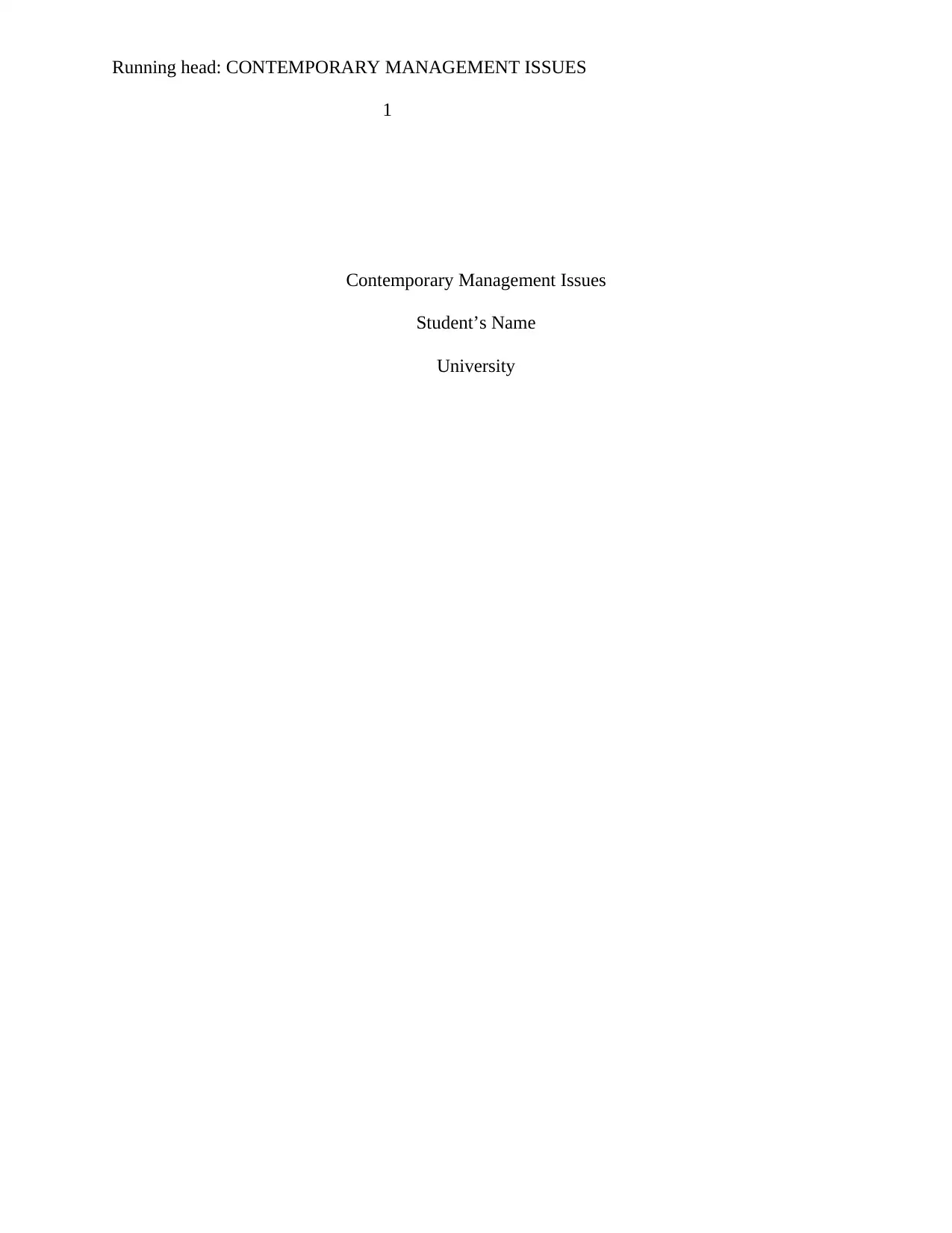
Running head: CONTEMPORARY MANAGEMENT ISSUES
1
Contemporary Management Issues
Student’s Name
University
1
Contemporary Management Issues
Student’s Name
University
Paraphrase This Document
Need a fresh take? Get an instant paraphrase of this document with our AI Paraphraser
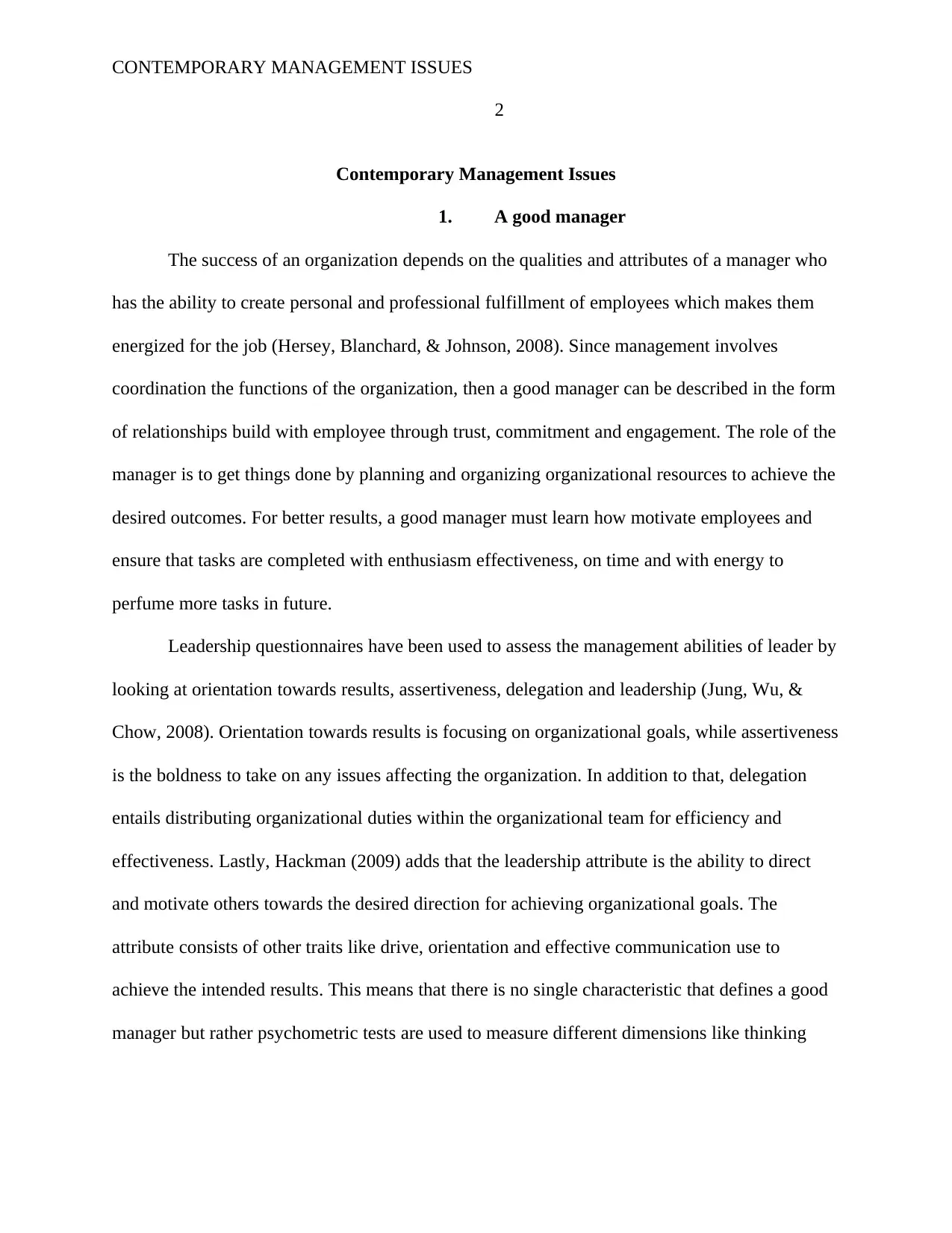
CONTEMPORARY MANAGEMENT ISSUES
2
Contemporary Management Issues
1. A good manager
The success of an organization depends on the qualities and attributes of a manager who
has the ability to create personal and professional fulfillment of employees which makes them
energized for the job (Hersey, Blanchard, & Johnson, 2008). Since management involves
coordination the functions of the organization, then a good manager can be described in the form
of relationships build with employee through trust, commitment and engagement. The role of the
manager is to get things done by planning and organizing organizational resources to achieve the
desired outcomes. For better results, a good manager must learn how motivate employees and
ensure that tasks are completed with enthusiasm effectiveness, on time and with energy to
perfume more tasks in future.
Leadership questionnaires have been used to assess the management abilities of leader by
looking at orientation towards results, assertiveness, delegation and leadership (Jung, Wu, &
Chow, 2008). Orientation towards results is focusing on organizational goals, while assertiveness
is the boldness to take on any issues affecting the organization. In addition to that, delegation
entails distributing organizational duties within the organizational team for efficiency and
effectiveness. Lastly, Hackman (2009) adds that the leadership attribute is the ability to direct
and motivate others towards the desired direction for achieving organizational goals. The
attribute consists of other traits like drive, orientation and effective communication use to
achieve the intended results. This means that there is no single characteristic that defines a good
manager but rather psychometric tests are used to measure different dimensions like thinking
2
Contemporary Management Issues
1. A good manager
The success of an organization depends on the qualities and attributes of a manager who
has the ability to create personal and professional fulfillment of employees which makes them
energized for the job (Hersey, Blanchard, & Johnson, 2008). Since management involves
coordination the functions of the organization, then a good manager can be described in the form
of relationships build with employee through trust, commitment and engagement. The role of the
manager is to get things done by planning and organizing organizational resources to achieve the
desired outcomes. For better results, a good manager must learn how motivate employees and
ensure that tasks are completed with enthusiasm effectiveness, on time and with energy to
perfume more tasks in future.
Leadership questionnaires have been used to assess the management abilities of leader by
looking at orientation towards results, assertiveness, delegation and leadership (Jung, Wu, &
Chow, 2008). Orientation towards results is focusing on organizational goals, while assertiveness
is the boldness to take on any issues affecting the organization. In addition to that, delegation
entails distributing organizational duties within the organizational team for efficiency and
effectiveness. Lastly, Hackman (2009) adds that the leadership attribute is the ability to direct
and motivate others towards the desired direction for achieving organizational goals. The
attribute consists of other traits like drive, orientation and effective communication use to
achieve the intended results. This means that there is no single characteristic that defines a good
manager but rather psychometric tests are used to measure different dimensions like thinking
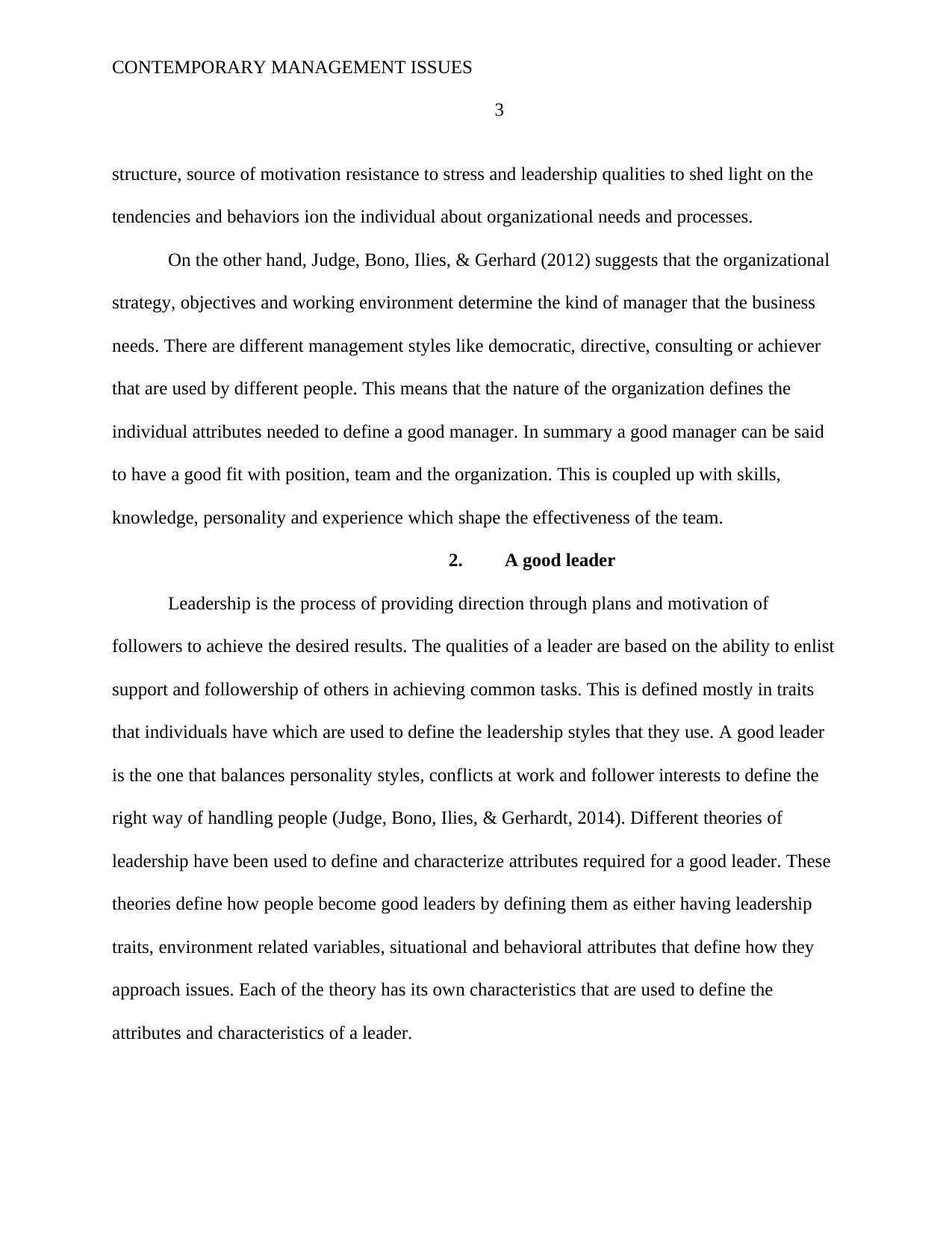
CONTEMPORARY MANAGEMENT ISSUES
3
structure, source of motivation resistance to stress and leadership qualities to shed light on the
tendencies and behaviors ion the individual about organizational needs and processes.
On the other hand, Judge, Bono, Ilies, & Gerhard (2012) suggests that the organizational
strategy, objectives and working environment determine the kind of manager that the business
needs. There are different management styles like democratic, directive, consulting or achiever
that are used by different people. This means that the nature of the organization defines the
individual attributes needed to define a good manager. In summary a good manager can be said
to have a good fit with position, team and the organization. This is coupled up with skills,
knowledge, personality and experience which shape the effectiveness of the team.
2. A good leader
Leadership is the process of providing direction through plans and motivation of
followers to achieve the desired results. The qualities of a leader are based on the ability to enlist
support and followership of others in achieving common tasks. This is defined mostly in traits
that individuals have which are used to define the leadership styles that they use. A good leader
is the one that balances personality styles, conflicts at work and follower interests to define the
right way of handling people (Judge, Bono, Ilies, & Gerhardt, 2014). Different theories of
leadership have been used to define and characterize attributes required for a good leader. These
theories define how people become good leaders by defining them as either having leadership
traits, environment related variables, situational and behavioral attributes that define how they
approach issues. Each of the theory has its own characteristics that are used to define the
attributes and characteristics of a leader.
3
structure, source of motivation resistance to stress and leadership qualities to shed light on the
tendencies and behaviors ion the individual about organizational needs and processes.
On the other hand, Judge, Bono, Ilies, & Gerhard (2012) suggests that the organizational
strategy, objectives and working environment determine the kind of manager that the business
needs. There are different management styles like democratic, directive, consulting or achiever
that are used by different people. This means that the nature of the organization defines the
individual attributes needed to define a good manager. In summary a good manager can be said
to have a good fit with position, team and the organization. This is coupled up with skills,
knowledge, personality and experience which shape the effectiveness of the team.
2. A good leader
Leadership is the process of providing direction through plans and motivation of
followers to achieve the desired results. The qualities of a leader are based on the ability to enlist
support and followership of others in achieving common tasks. This is defined mostly in traits
that individuals have which are used to define the leadership styles that they use. A good leader
is the one that balances personality styles, conflicts at work and follower interests to define the
right way of handling people (Judge, Bono, Ilies, & Gerhardt, 2014). Different theories of
leadership have been used to define and characterize attributes required for a good leader. These
theories define how people become good leaders by defining them as either having leadership
traits, environment related variables, situational and behavioral attributes that define how they
approach issues. Each of the theory has its own characteristics that are used to define the
attributes and characteristics of a leader.
⊘ This is a preview!⊘
Do you want full access?
Subscribe today to unlock all pages.

Trusted by 1+ million students worldwide
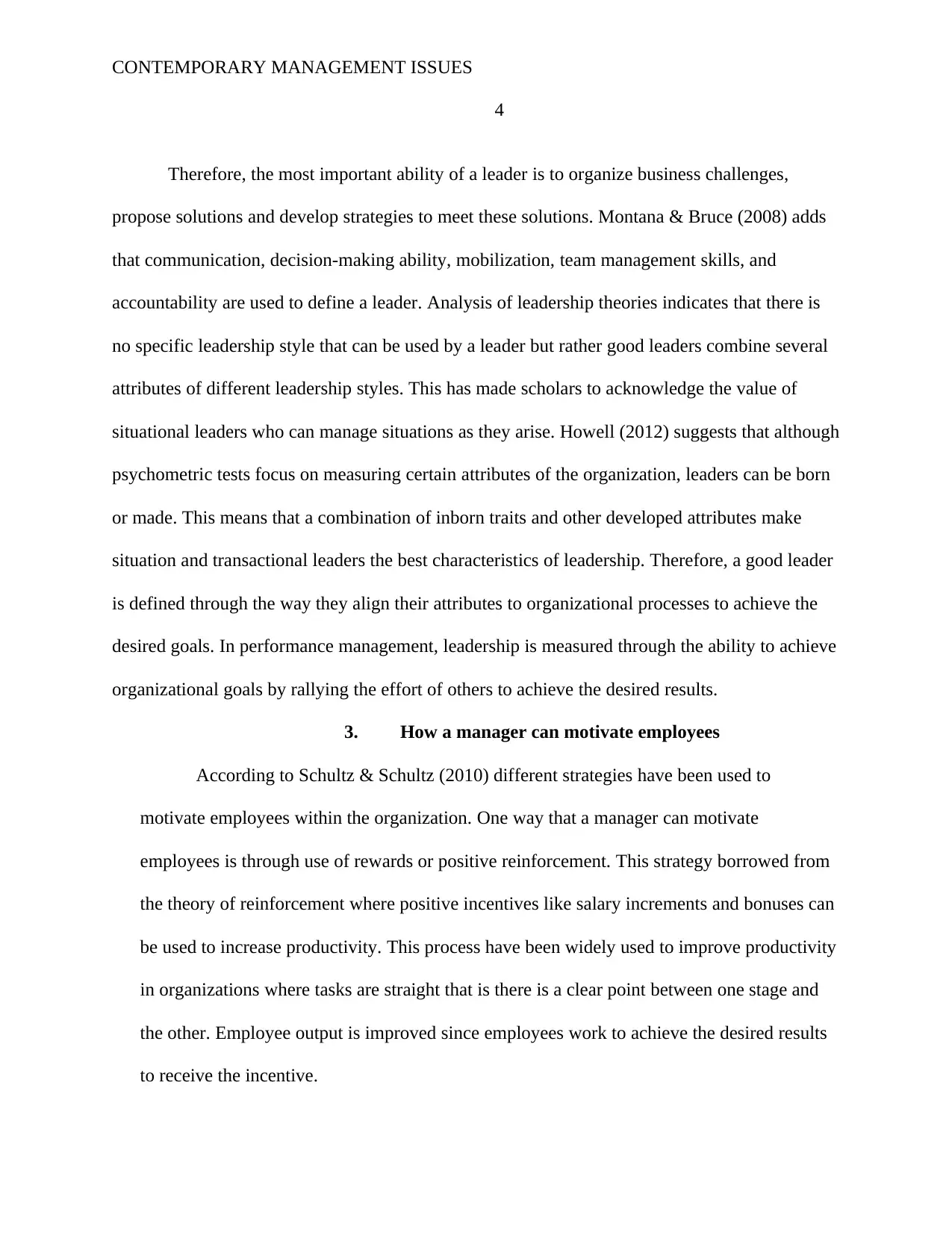
CONTEMPORARY MANAGEMENT ISSUES
4
Therefore, the most important ability of a leader is to organize business challenges,
propose solutions and develop strategies to meet these solutions. Montana & Bruce (2008) adds
that communication, decision-making ability, mobilization, team management skills, and
accountability are used to define a leader. Analysis of leadership theories indicates that there is
no specific leadership style that can be used by a leader but rather good leaders combine several
attributes of different leadership styles. This has made scholars to acknowledge the value of
situational leaders who can manage situations as they arise. Howell (2012) suggests that although
psychometric tests focus on measuring certain attributes of the organization, leaders can be born
or made. This means that a combination of inborn traits and other developed attributes make
situation and transactional leaders the best characteristics of leadership. Therefore, a good leader
is defined through the way they align their attributes to organizational processes to achieve the
desired goals. In performance management, leadership is measured through the ability to achieve
organizational goals by rallying the effort of others to achieve the desired results.
3. How a manager can motivate employees
According to Schultz & Schultz (2010) different strategies have been used to
motivate employees within the organization. One way that a manager can motivate
employees is through use of rewards or positive reinforcement. This strategy borrowed from
the theory of reinforcement where positive incentives like salary increments and bonuses can
be used to increase productivity. This process have been widely used to improve productivity
in organizations where tasks are straight that is there is a clear point between one stage and
the other. Employee output is improved since employees work to achieve the desired results
to receive the incentive.
4
Therefore, the most important ability of a leader is to organize business challenges,
propose solutions and develop strategies to meet these solutions. Montana & Bruce (2008) adds
that communication, decision-making ability, mobilization, team management skills, and
accountability are used to define a leader. Analysis of leadership theories indicates that there is
no specific leadership style that can be used by a leader but rather good leaders combine several
attributes of different leadership styles. This has made scholars to acknowledge the value of
situational leaders who can manage situations as they arise. Howell (2012) suggests that although
psychometric tests focus on measuring certain attributes of the organization, leaders can be born
or made. This means that a combination of inborn traits and other developed attributes make
situation and transactional leaders the best characteristics of leadership. Therefore, a good leader
is defined through the way they align their attributes to organizational processes to achieve the
desired goals. In performance management, leadership is measured through the ability to achieve
organizational goals by rallying the effort of others to achieve the desired results.
3. How a manager can motivate employees
According to Schultz & Schultz (2010) different strategies have been used to
motivate employees within the organization. One way that a manager can motivate
employees is through use of rewards or positive reinforcement. This strategy borrowed from
the theory of reinforcement where positive incentives like salary increments and bonuses can
be used to increase productivity. This process have been widely used to improve productivity
in organizations where tasks are straight that is there is a clear point between one stage and
the other. Employee output is improved since employees work to achieve the desired results
to receive the incentive.
Paraphrase This Document
Need a fresh take? Get an instant paraphrase of this document with our AI Paraphraser
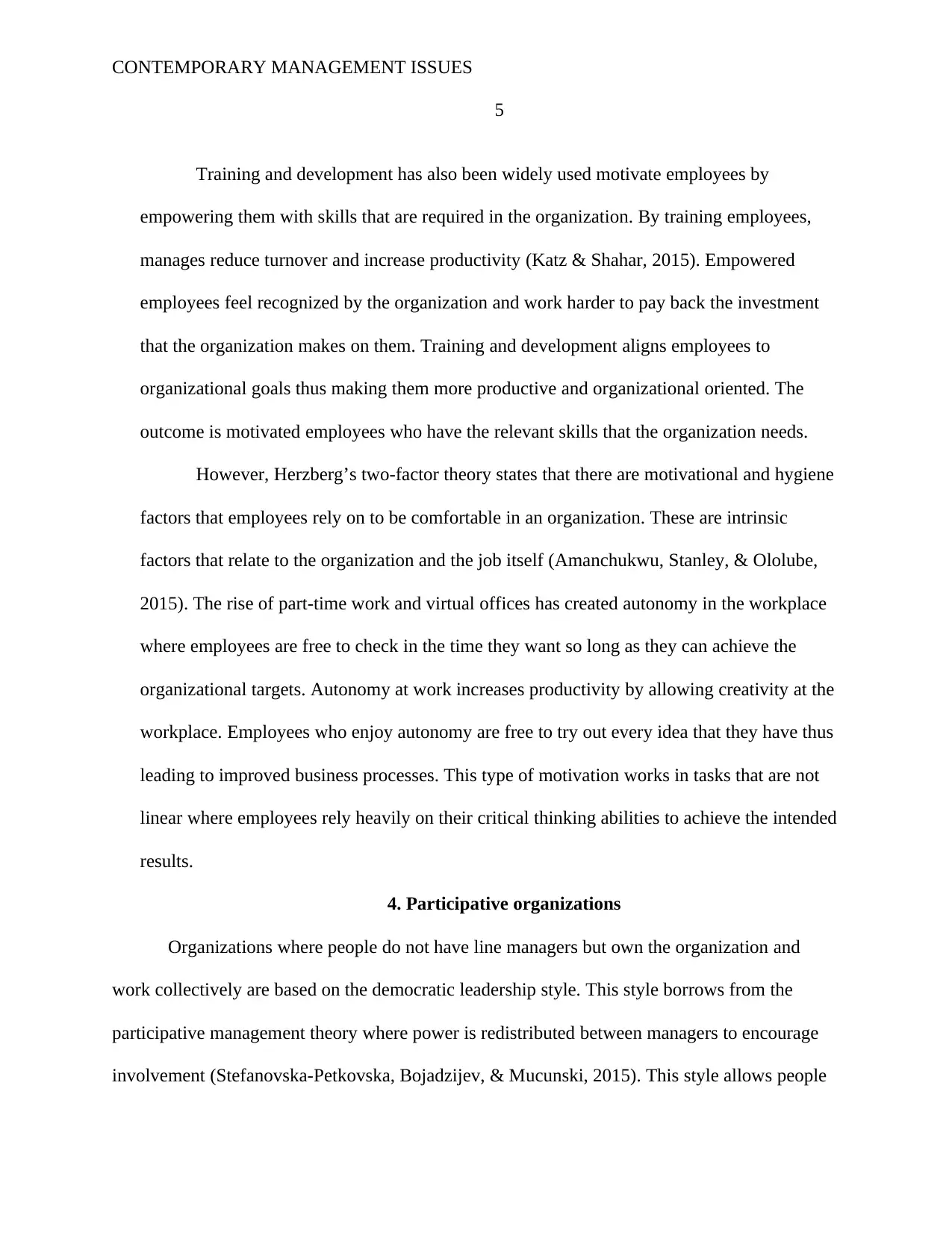
CONTEMPORARY MANAGEMENT ISSUES
5
Training and development has also been widely used motivate employees by
empowering them with skills that are required in the organization. By training employees,
manages reduce turnover and increase productivity (Katz & Shahar, 2015). Empowered
employees feel recognized by the organization and work harder to pay back the investment
that the organization makes on them. Training and development aligns employees to
organizational goals thus making them more productive and organizational oriented. The
outcome is motivated employees who have the relevant skills that the organization needs.
However, Herzberg’s two-factor theory states that there are motivational and hygiene
factors that employees rely on to be comfortable in an organization. These are intrinsic
factors that relate to the organization and the job itself (Amanchukwu, Stanley, & Ololube,
2015). The rise of part-time work and virtual offices has created autonomy in the workplace
where employees are free to check in the time they want so long as they can achieve the
organizational targets. Autonomy at work increases productivity by allowing creativity at the
workplace. Employees who enjoy autonomy are free to try out every idea that they have thus
leading to improved business processes. This type of motivation works in tasks that are not
linear where employees rely heavily on their critical thinking abilities to achieve the intended
results.
4. Participative organizations
Organizations where people do not have line managers but own the organization and
work collectively are based on the democratic leadership style. This style borrows from the
participative management theory where power is redistributed between managers to encourage
involvement (Stefanovska-Petkovska, Bojadzijev, & Mucunski, 2015). This style allows people
5
Training and development has also been widely used motivate employees by
empowering them with skills that are required in the organization. By training employees,
manages reduce turnover and increase productivity (Katz & Shahar, 2015). Empowered
employees feel recognized by the organization and work harder to pay back the investment
that the organization makes on them. Training and development aligns employees to
organizational goals thus making them more productive and organizational oriented. The
outcome is motivated employees who have the relevant skills that the organization needs.
However, Herzberg’s two-factor theory states that there are motivational and hygiene
factors that employees rely on to be comfortable in an organization. These are intrinsic
factors that relate to the organization and the job itself (Amanchukwu, Stanley, & Ololube,
2015). The rise of part-time work and virtual offices has created autonomy in the workplace
where employees are free to check in the time they want so long as they can achieve the
organizational targets. Autonomy at work increases productivity by allowing creativity at the
workplace. Employees who enjoy autonomy are free to try out every idea that they have thus
leading to improved business processes. This type of motivation works in tasks that are not
linear where employees rely heavily on their critical thinking abilities to achieve the intended
results.
4. Participative organizations
Organizations where people do not have line managers but own the organization and
work collectively are based on the democratic leadership style. This style borrows from the
participative management theory where power is redistributed between managers to encourage
involvement (Stefanovska-Petkovska, Bojadzijev, & Mucunski, 2015). This style allows people
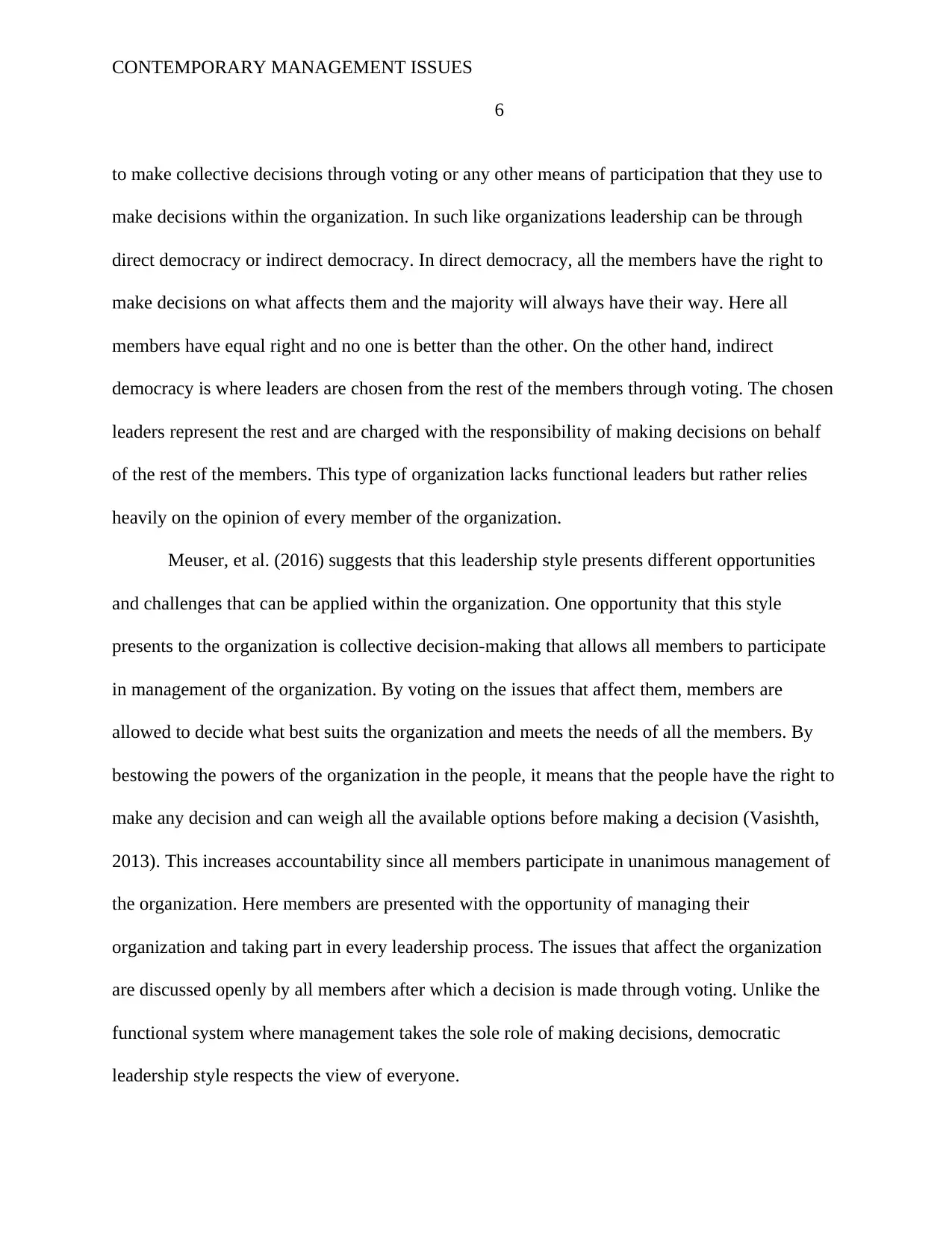
CONTEMPORARY MANAGEMENT ISSUES
6
to make collective decisions through voting or any other means of participation that they use to
make decisions within the organization. In such like organizations leadership can be through
direct democracy or indirect democracy. In direct democracy, all the members have the right to
make decisions on what affects them and the majority will always have their way. Here all
members have equal right and no one is better than the other. On the other hand, indirect
democracy is where leaders are chosen from the rest of the members through voting. The chosen
leaders represent the rest and are charged with the responsibility of making decisions on behalf
of the rest of the members. This type of organization lacks functional leaders but rather relies
heavily on the opinion of every member of the organization.
Meuser, et al. (2016) suggests that this leadership style presents different opportunities
and challenges that can be applied within the organization. One opportunity that this style
presents to the organization is collective decision-making that allows all members to participate
in management of the organization. By voting on the issues that affect them, members are
allowed to decide what best suits the organization and meets the needs of all the members. By
bestowing the powers of the organization in the people, it means that the people have the right to
make any decision and can weigh all the available options before making a decision (Vasishth,
2013). This increases accountability since all members participate in unanimous management of
the organization. Here members are presented with the opportunity of managing their
organization and taking part in every leadership process. The issues that affect the organization
are discussed openly by all members after which a decision is made through voting. Unlike the
functional system where management takes the sole role of making decisions, democratic
leadership style respects the view of everyone.
6
to make collective decisions through voting or any other means of participation that they use to
make decisions within the organization. In such like organizations leadership can be through
direct democracy or indirect democracy. In direct democracy, all the members have the right to
make decisions on what affects them and the majority will always have their way. Here all
members have equal right and no one is better than the other. On the other hand, indirect
democracy is where leaders are chosen from the rest of the members through voting. The chosen
leaders represent the rest and are charged with the responsibility of making decisions on behalf
of the rest of the members. This type of organization lacks functional leaders but rather relies
heavily on the opinion of every member of the organization.
Meuser, et al. (2016) suggests that this leadership style presents different opportunities
and challenges that can be applied within the organization. One opportunity that this style
presents to the organization is collective decision-making that allows all members to participate
in management of the organization. By voting on the issues that affect them, members are
allowed to decide what best suits the organization and meets the needs of all the members. By
bestowing the powers of the organization in the people, it means that the people have the right to
make any decision and can weigh all the available options before making a decision (Vasishth,
2013). This increases accountability since all members participate in unanimous management of
the organization. Here members are presented with the opportunity of managing their
organization and taking part in every leadership process. The issues that affect the organization
are discussed openly by all members after which a decision is made through voting. Unlike the
functional system where management takes the sole role of making decisions, democratic
leadership style respects the view of everyone.
⊘ This is a preview!⊘
Do you want full access?
Subscribe today to unlock all pages.

Trusted by 1+ million students worldwide
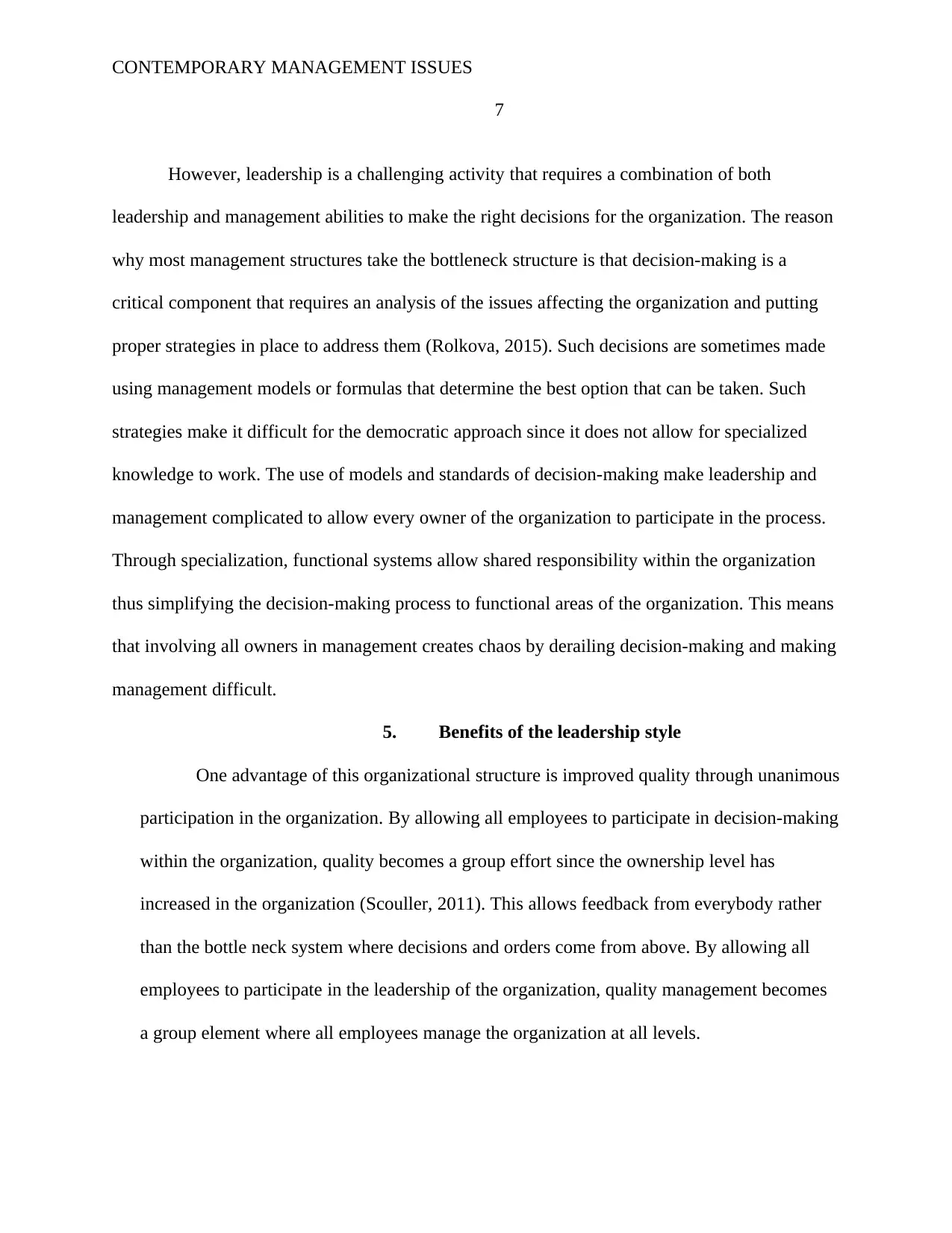
CONTEMPORARY MANAGEMENT ISSUES
7
However, leadership is a challenging activity that requires a combination of both
leadership and management abilities to make the right decisions for the organization. The reason
why most management structures take the bottleneck structure is that decision-making is a
critical component that requires an analysis of the issues affecting the organization and putting
proper strategies in place to address them (Rolkova, 2015). Such decisions are sometimes made
using management models or formulas that determine the best option that can be taken. Such
strategies make it difficult for the democratic approach since it does not allow for specialized
knowledge to work. The use of models and standards of decision-making make leadership and
management complicated to allow every owner of the organization to participate in the process.
Through specialization, functional systems allow shared responsibility within the organization
thus simplifying the decision-making process to functional areas of the organization. This means
that involving all owners in management creates chaos by derailing decision-making and making
management difficult.
5. Benefits of the leadership style
One advantage of this organizational structure is improved quality through unanimous
participation in the organization. By allowing all employees to participate in decision-making
within the organization, quality becomes a group effort since the ownership level has
increased in the organization (Scouller, 2011). This allows feedback from everybody rather
than the bottle neck system where decisions and orders come from above. By allowing all
employees to participate in the leadership of the organization, quality management becomes
a group element where all employees manage the organization at all levels.
7
However, leadership is a challenging activity that requires a combination of both
leadership and management abilities to make the right decisions for the organization. The reason
why most management structures take the bottleneck structure is that decision-making is a
critical component that requires an analysis of the issues affecting the organization and putting
proper strategies in place to address them (Rolkova, 2015). Such decisions are sometimes made
using management models or formulas that determine the best option that can be taken. Such
strategies make it difficult for the democratic approach since it does not allow for specialized
knowledge to work. The use of models and standards of decision-making make leadership and
management complicated to allow every owner of the organization to participate in the process.
Through specialization, functional systems allow shared responsibility within the organization
thus simplifying the decision-making process to functional areas of the organization. This means
that involving all owners in management creates chaos by derailing decision-making and making
management difficult.
5. Benefits of the leadership style
One advantage of this organizational structure is improved quality through unanimous
participation in the organization. By allowing all employees to participate in decision-making
within the organization, quality becomes a group effort since the ownership level has
increased in the organization (Scouller, 2011). This allows feedback from everybody rather
than the bottle neck system where decisions and orders come from above. By allowing all
employees to participate in the leadership of the organization, quality management becomes
a group element where all employees manage the organization at all levels.
Paraphrase This Document
Need a fresh take? Get an instant paraphrase of this document with our AI Paraphraser
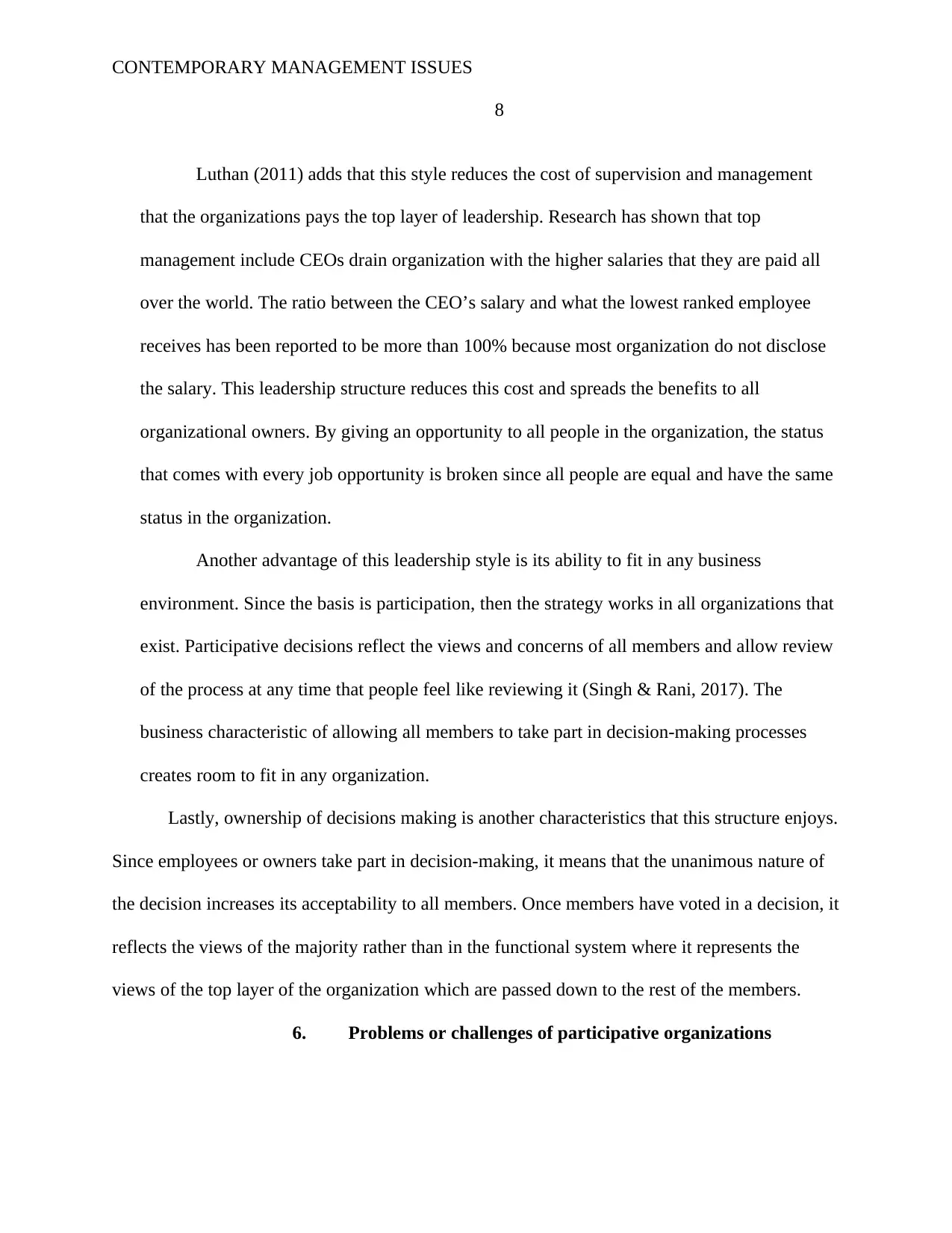
CONTEMPORARY MANAGEMENT ISSUES
8
Luthan (2011) adds that this style reduces the cost of supervision and management
that the organizations pays the top layer of leadership. Research has shown that top
management include CEOs drain organization with the higher salaries that they are paid all
over the world. The ratio between the CEO’s salary and what the lowest ranked employee
receives has been reported to be more than 100% because most organization do not disclose
the salary. This leadership structure reduces this cost and spreads the benefits to all
organizational owners. By giving an opportunity to all people in the organization, the status
that comes with every job opportunity is broken since all people are equal and have the same
status in the organization.
Another advantage of this leadership style is its ability to fit in any business
environment. Since the basis is participation, then the strategy works in all organizations that
exist. Participative decisions reflect the views and concerns of all members and allow review
of the process at any time that people feel like reviewing it (Singh & Rani, 2017). The
business characteristic of allowing all members to take part in decision-making processes
creates room to fit in any organization.
Lastly, ownership of decisions making is another characteristics that this structure enjoys.
Since employees or owners take part in decision-making, it means that the unanimous nature of
the decision increases its acceptability to all members. Once members have voted in a decision, it
reflects the views of the majority rather than in the functional system where it represents the
views of the top layer of the organization which are passed down to the rest of the members.
6. Problems or challenges of participative organizations
8
Luthan (2011) adds that this style reduces the cost of supervision and management
that the organizations pays the top layer of leadership. Research has shown that top
management include CEOs drain organization with the higher salaries that they are paid all
over the world. The ratio between the CEO’s salary and what the lowest ranked employee
receives has been reported to be more than 100% because most organization do not disclose
the salary. This leadership structure reduces this cost and spreads the benefits to all
organizational owners. By giving an opportunity to all people in the organization, the status
that comes with every job opportunity is broken since all people are equal and have the same
status in the organization.
Another advantage of this leadership style is its ability to fit in any business
environment. Since the basis is participation, then the strategy works in all organizations that
exist. Participative decisions reflect the views and concerns of all members and allow review
of the process at any time that people feel like reviewing it (Singh & Rani, 2017). The
business characteristic of allowing all members to take part in decision-making processes
creates room to fit in any organization.
Lastly, ownership of decisions making is another characteristics that this structure enjoys.
Since employees or owners take part in decision-making, it means that the unanimous nature of
the decision increases its acceptability to all members. Once members have voted in a decision, it
reflects the views of the majority rather than in the functional system where it represents the
views of the top layer of the organization which are passed down to the rest of the members.
6. Problems or challenges of participative organizations
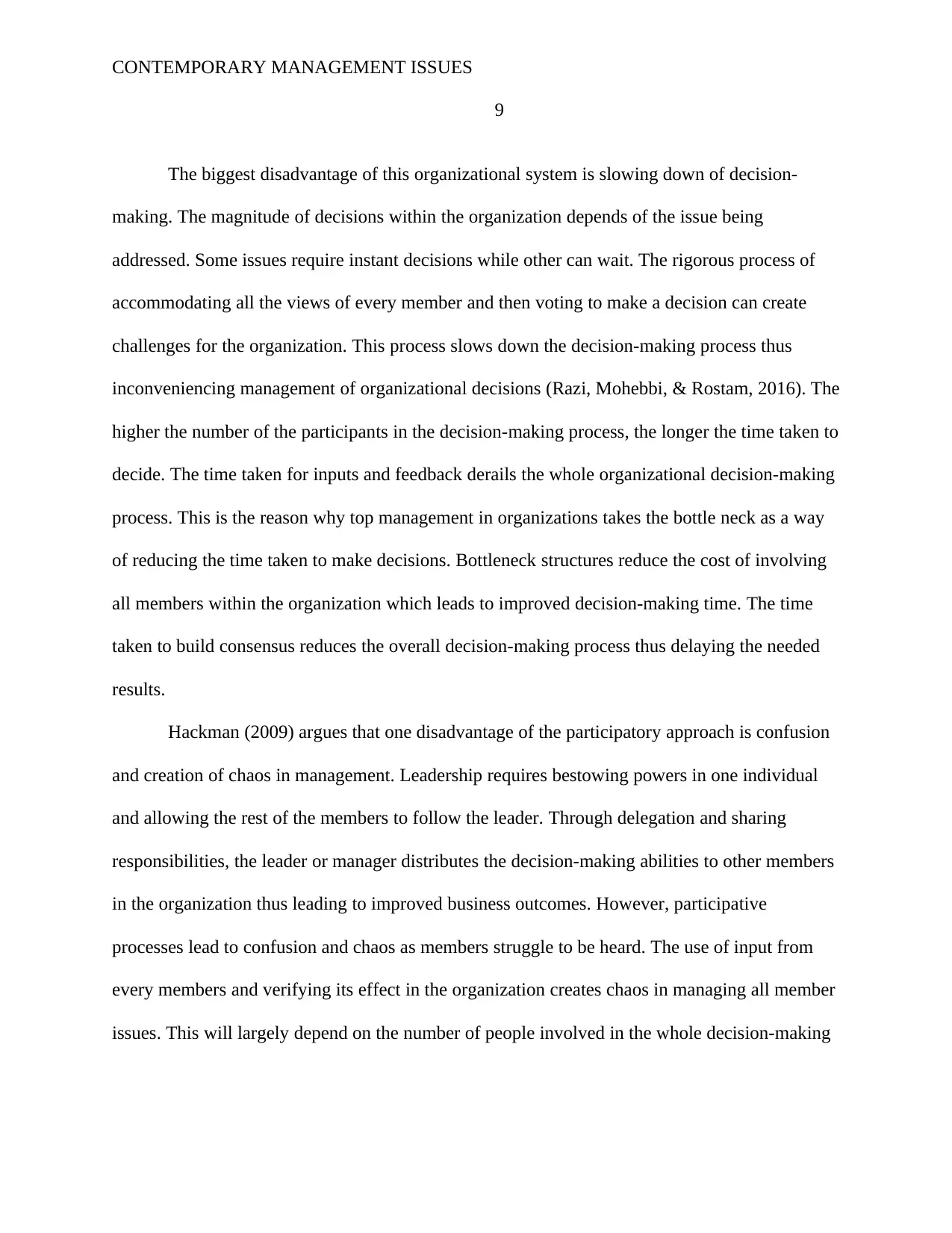
CONTEMPORARY MANAGEMENT ISSUES
9
The biggest disadvantage of this organizational system is slowing down of decision-
making. The magnitude of decisions within the organization depends of the issue being
addressed. Some issues require instant decisions while other can wait. The rigorous process of
accommodating all the views of every member and then voting to make a decision can create
challenges for the organization. This process slows down the decision-making process thus
inconveniencing management of organizational decisions (Razi, Mohebbi, & Rostam, 2016). The
higher the number of the participants in the decision-making process, the longer the time taken to
decide. The time taken for inputs and feedback derails the whole organizational decision-making
process. This is the reason why top management in organizations takes the bottle neck as a way
of reducing the time taken to make decisions. Bottleneck structures reduce the cost of involving
all members within the organization which leads to improved decision-making time. The time
taken to build consensus reduces the overall decision-making process thus delaying the needed
results.
Hackman (2009) argues that one disadvantage of the participatory approach is confusion
and creation of chaos in management. Leadership requires bestowing powers in one individual
and allowing the rest of the members to follow the leader. Through delegation and sharing
responsibilities, the leader or manager distributes the decision-making abilities to other members
in the organization thus leading to improved business outcomes. However, participative
processes lead to confusion and chaos as members struggle to be heard. The use of input from
every members and verifying its effect in the organization creates chaos in managing all member
issues. This will largely depend on the number of people involved in the whole decision-making
9
The biggest disadvantage of this organizational system is slowing down of decision-
making. The magnitude of decisions within the organization depends of the issue being
addressed. Some issues require instant decisions while other can wait. The rigorous process of
accommodating all the views of every member and then voting to make a decision can create
challenges for the organization. This process slows down the decision-making process thus
inconveniencing management of organizational decisions (Razi, Mohebbi, & Rostam, 2016). The
higher the number of the participants in the decision-making process, the longer the time taken to
decide. The time taken for inputs and feedback derails the whole organizational decision-making
process. This is the reason why top management in organizations takes the bottle neck as a way
of reducing the time taken to make decisions. Bottleneck structures reduce the cost of involving
all members within the organization which leads to improved decision-making time. The time
taken to build consensus reduces the overall decision-making process thus delaying the needed
results.
Hackman (2009) argues that one disadvantage of the participatory approach is confusion
and creation of chaos in management. Leadership requires bestowing powers in one individual
and allowing the rest of the members to follow the leader. Through delegation and sharing
responsibilities, the leader or manager distributes the decision-making abilities to other members
in the organization thus leading to improved business outcomes. However, participative
processes lead to confusion and chaos as members struggle to be heard. The use of input from
every members and verifying its effect in the organization creates chaos in managing all member
issues. This will largely depend on the number of people involved in the whole decision-making
⊘ This is a preview!⊘
Do you want full access?
Subscribe today to unlock all pages.

Trusted by 1+ million students worldwide
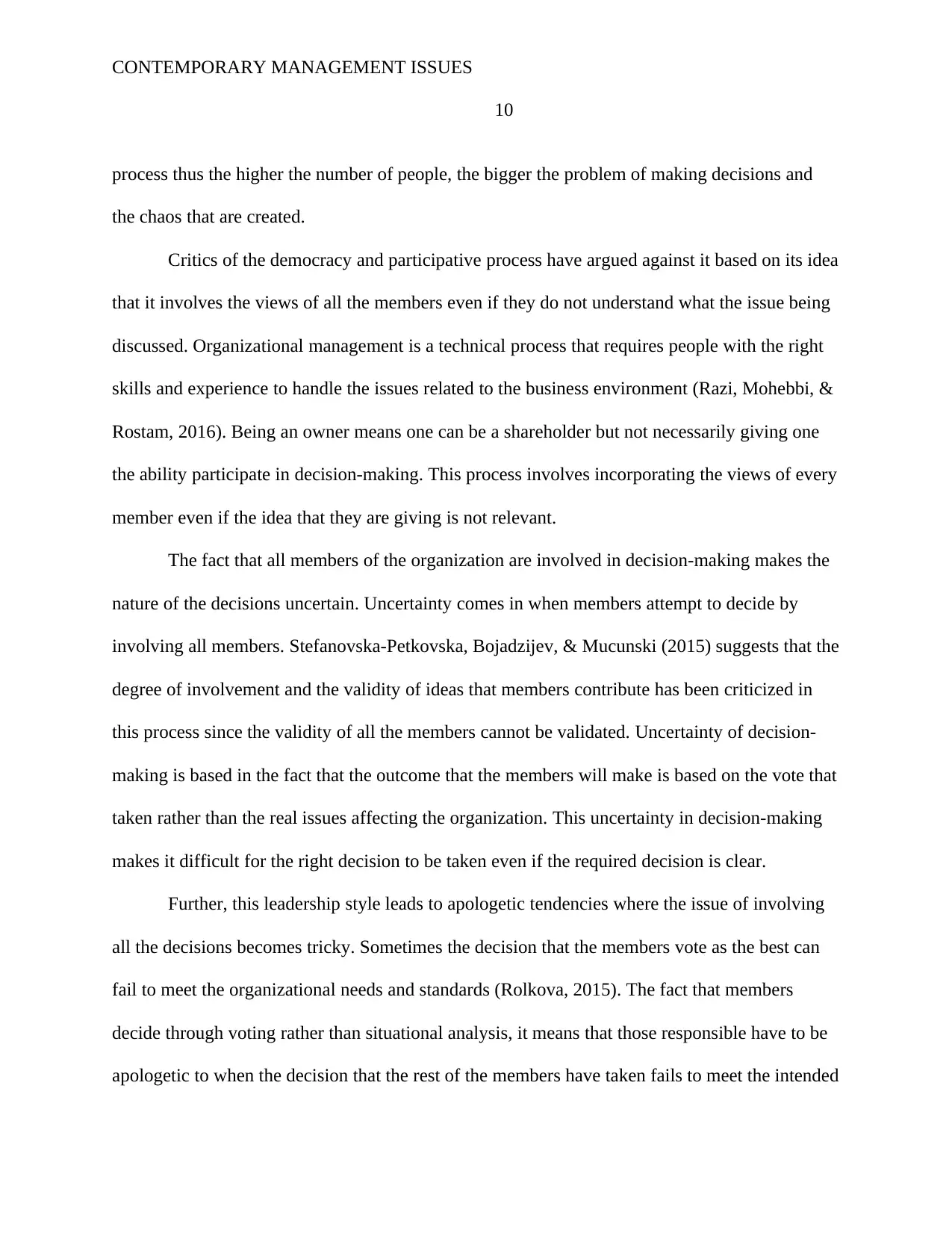
CONTEMPORARY MANAGEMENT ISSUES
10
process thus the higher the number of people, the bigger the problem of making decisions and
the chaos that are created.
Critics of the democracy and participative process have argued against it based on its idea
that it involves the views of all the members even if they do not understand what the issue being
discussed. Organizational management is a technical process that requires people with the right
skills and experience to handle the issues related to the business environment (Razi, Mohebbi, &
Rostam, 2016). Being an owner means one can be a shareholder but not necessarily giving one
the ability participate in decision-making. This process involves incorporating the views of every
member even if the idea that they are giving is not relevant.
The fact that all members of the organization are involved in decision-making makes the
nature of the decisions uncertain. Uncertainty comes in when members attempt to decide by
involving all members. Stefanovska-Petkovska, Bojadzijev, & Mucunski (2015) suggests that the
degree of involvement and the validity of ideas that members contribute has been criticized in
this process since the validity of all the members cannot be validated. Uncertainty of decision-
making is based in the fact that the outcome that the members will make is based on the vote that
taken rather than the real issues affecting the organization. This uncertainty in decision-making
makes it difficult for the right decision to be taken even if the required decision is clear.
Further, this leadership style leads to apologetic tendencies where the issue of involving
all the decisions becomes tricky. Sometimes the decision that the members vote as the best can
fail to meet the organizational needs and standards (Rolkova, 2015). The fact that members
decide through voting rather than situational analysis, it means that those responsible have to be
apologetic to when the decision that the rest of the members have taken fails to meet the intended
10
process thus the higher the number of people, the bigger the problem of making decisions and
the chaos that are created.
Critics of the democracy and participative process have argued against it based on its idea
that it involves the views of all the members even if they do not understand what the issue being
discussed. Organizational management is a technical process that requires people with the right
skills and experience to handle the issues related to the business environment (Razi, Mohebbi, &
Rostam, 2016). Being an owner means one can be a shareholder but not necessarily giving one
the ability participate in decision-making. This process involves incorporating the views of every
member even if the idea that they are giving is not relevant.
The fact that all members of the organization are involved in decision-making makes the
nature of the decisions uncertain. Uncertainty comes in when members attempt to decide by
involving all members. Stefanovska-Petkovska, Bojadzijev, & Mucunski (2015) suggests that the
degree of involvement and the validity of ideas that members contribute has been criticized in
this process since the validity of all the members cannot be validated. Uncertainty of decision-
making is based in the fact that the outcome that the members will make is based on the vote that
taken rather than the real issues affecting the organization. This uncertainty in decision-making
makes it difficult for the right decision to be taken even if the required decision is clear.
Further, this leadership style leads to apologetic tendencies where the issue of involving
all the decisions becomes tricky. Sometimes the decision that the members vote as the best can
fail to meet the organizational needs and standards (Rolkova, 2015). The fact that members
decide through voting rather than situational analysis, it means that those responsible have to be
apologetic to when the decision that the rest of the members have taken fails to meet the intended
Paraphrase This Document
Need a fresh take? Get an instant paraphrase of this document with our AI Paraphraser
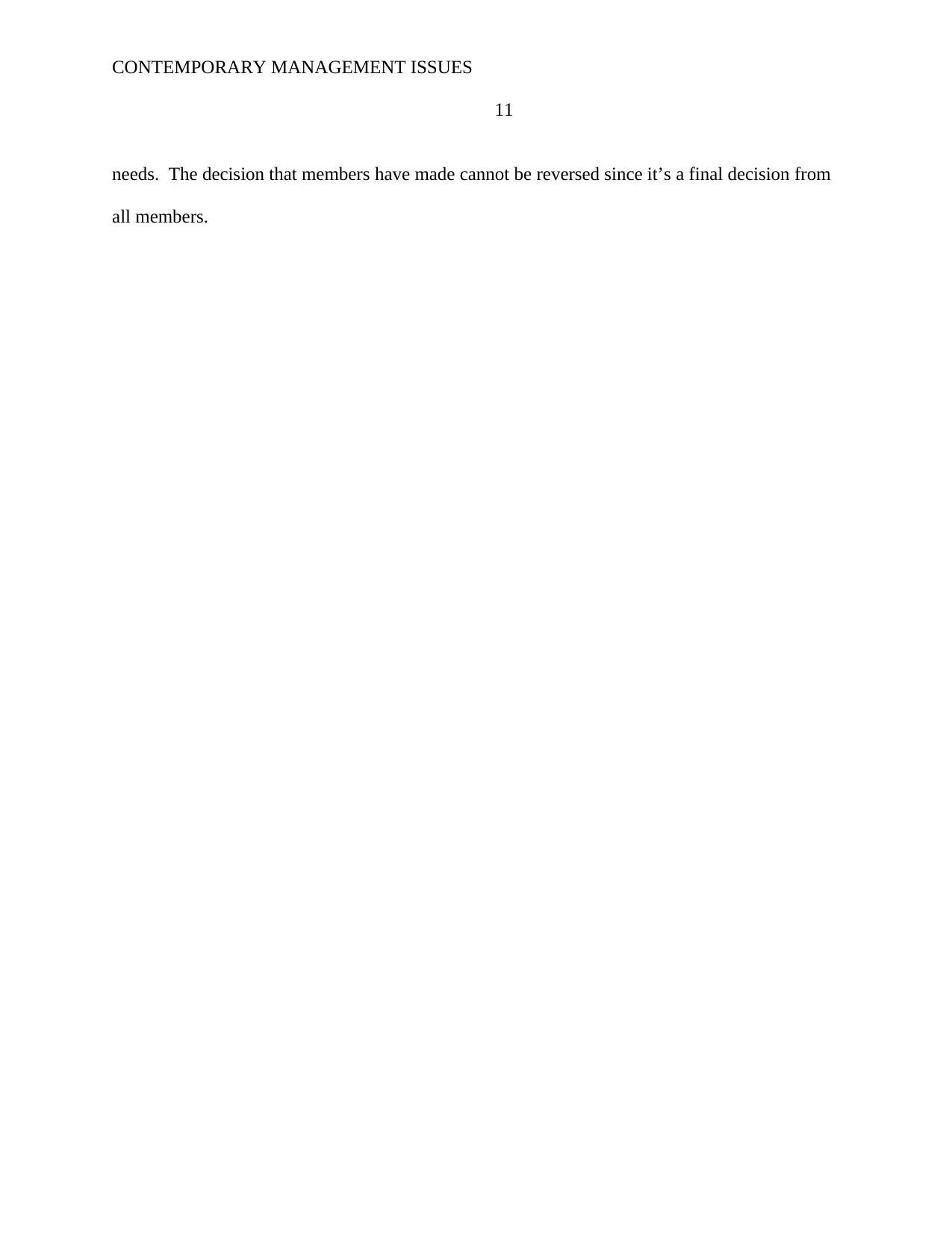
CONTEMPORARY MANAGEMENT ISSUES
11
needs. The decision that members have made cannot be reversed since it’s a final decision from
all members.
11
needs. The decision that members have made cannot be reversed since it’s a final decision from
all members.
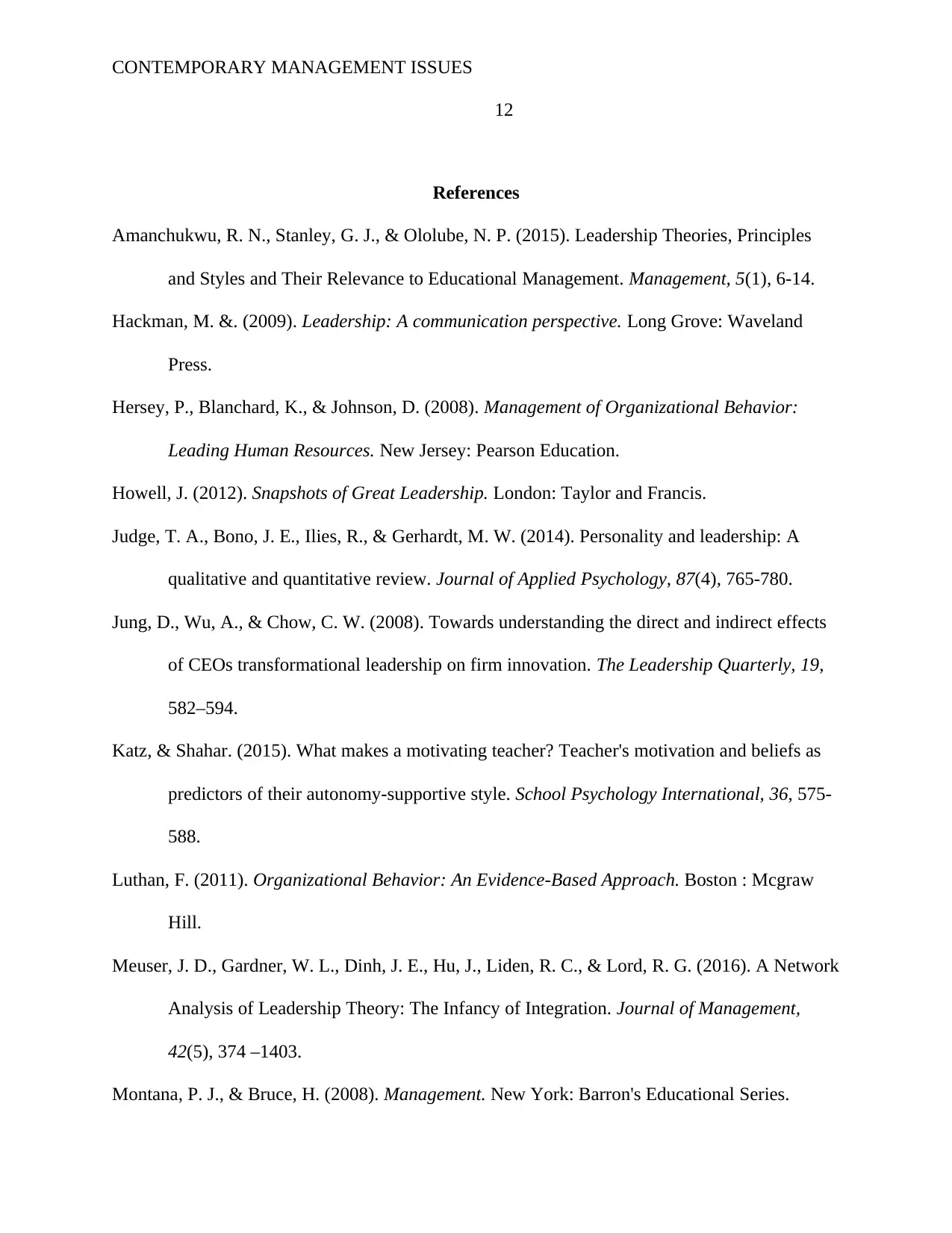
CONTEMPORARY MANAGEMENT ISSUES
12
References
Amanchukwu, R. N., Stanley, G. J., & Ololube, N. P. (2015). Leadership Theories, Principles
and Styles and Their Relevance to Educational Management. Management, 5(1), 6-14.
Hackman, M. &. (2009). Leadership: A communication perspective. Long Grove: Waveland
Press.
Hersey, P., Blanchard, K., & Johnson, D. (2008). Management of Organizational Behavior:
Leading Human Resources. New Jersey: Pearson Education.
Howell, J. (2012). Snapshots of Great Leadership. London: Taylor and Francis.
Judge, T. A., Bono, J. E., Ilies, R., & Gerhardt, M. W. (2014). Personality and leadership: A
qualitative and quantitative review. Journal of Applied Psychology, 87(4), 765-780.
Jung, D., Wu, A., & Chow, C. W. (2008). Towards understanding the direct and indirect effects
of CEOs transformational leadership on firm innovation. The Leadership Quarterly, 19,
582–594.
Katz, & Shahar. (2015). What makes a motivating teacher? Teacher's motivation and beliefs as
predictors of their autonomy-supportive style. School Psychology International, 36, 575-
588.
Luthan, F. (2011). Organizational Behavior: An Evidence-Based Approach. Boston : Mcgraw
Hill.
Meuser, J. D., Gardner, W. L., Dinh, J. E., Hu, J., Liden, R. C., & Lord, R. G. (2016). A Network
Analysis of Leadership Theory: The Infancy of Integration. Journal of Management,
42(5), 374 –1403.
Montana, P. J., & Bruce, H. (2008). Management. New York: Barron's Educational Series.
12
References
Amanchukwu, R. N., Stanley, G. J., & Ololube, N. P. (2015). Leadership Theories, Principles
and Styles and Their Relevance to Educational Management. Management, 5(1), 6-14.
Hackman, M. &. (2009). Leadership: A communication perspective. Long Grove: Waveland
Press.
Hersey, P., Blanchard, K., & Johnson, D. (2008). Management of Organizational Behavior:
Leading Human Resources. New Jersey: Pearson Education.
Howell, J. (2012). Snapshots of Great Leadership. London: Taylor and Francis.
Judge, T. A., Bono, J. E., Ilies, R., & Gerhardt, M. W. (2014). Personality and leadership: A
qualitative and quantitative review. Journal of Applied Psychology, 87(4), 765-780.
Jung, D., Wu, A., & Chow, C. W. (2008). Towards understanding the direct and indirect effects
of CEOs transformational leadership on firm innovation. The Leadership Quarterly, 19,
582–594.
Katz, & Shahar. (2015). What makes a motivating teacher? Teacher's motivation and beliefs as
predictors of their autonomy-supportive style. School Psychology International, 36, 575-
588.
Luthan, F. (2011). Organizational Behavior: An Evidence-Based Approach. Boston : Mcgraw
Hill.
Meuser, J. D., Gardner, W. L., Dinh, J. E., Hu, J., Liden, R. C., & Lord, R. G. (2016). A Network
Analysis of Leadership Theory: The Infancy of Integration. Journal of Management,
42(5), 374 –1403.
Montana, P. J., & Bruce, H. (2008). Management. New York: Barron's Educational Series.
⊘ This is a preview!⊘
Do you want full access?
Subscribe today to unlock all pages.

Trusted by 1+ million students worldwide
1 out of 13
Related Documents
Your All-in-One AI-Powered Toolkit for Academic Success.
+13062052269
info@desklib.com
Available 24*7 on WhatsApp / Email
![[object Object]](/_next/static/media/star-bottom.7253800d.svg)
Unlock your academic potential
Copyright © 2020–2025 A2Z Services. All Rights Reserved. Developed and managed by ZUCOL.





